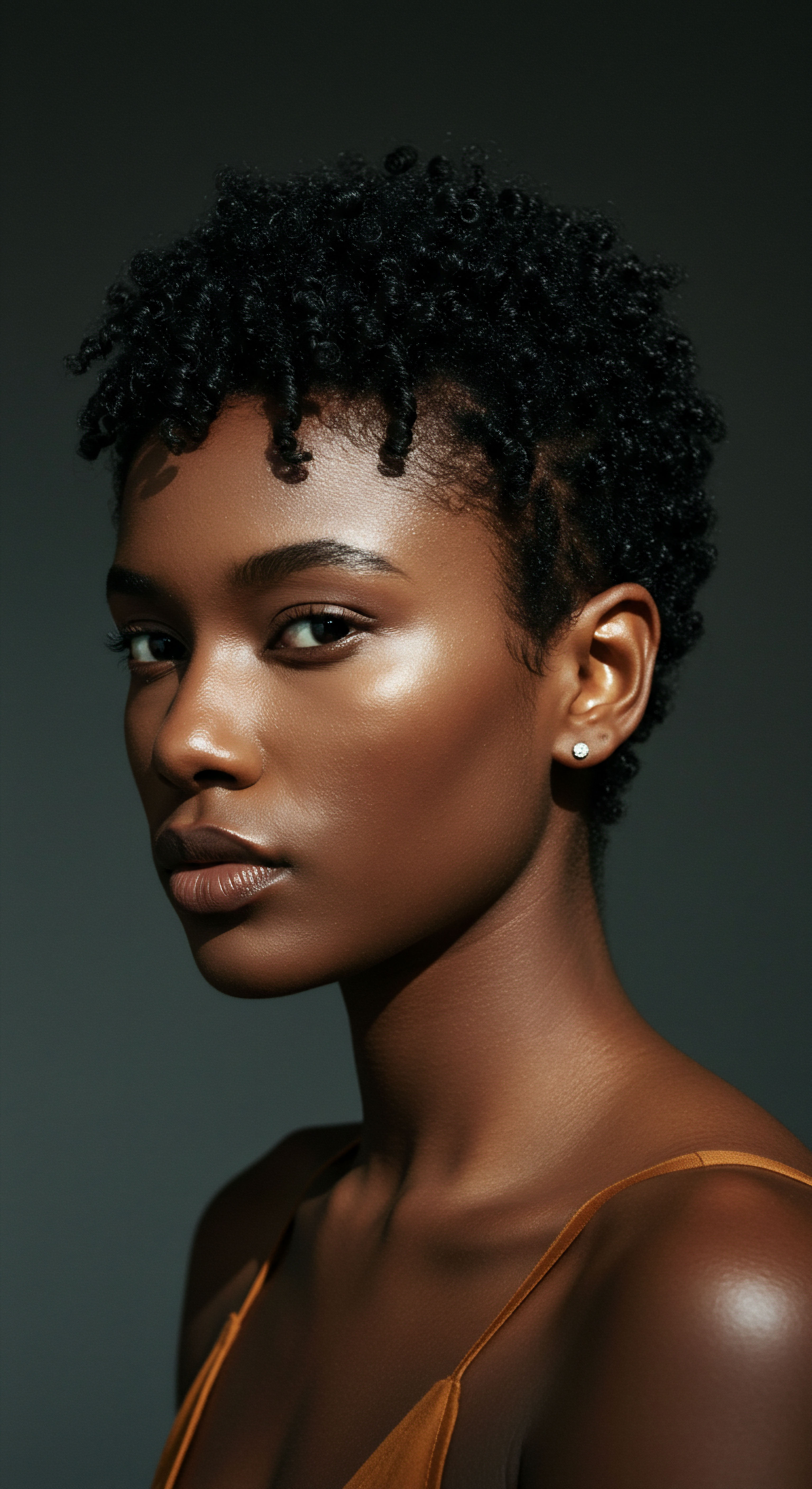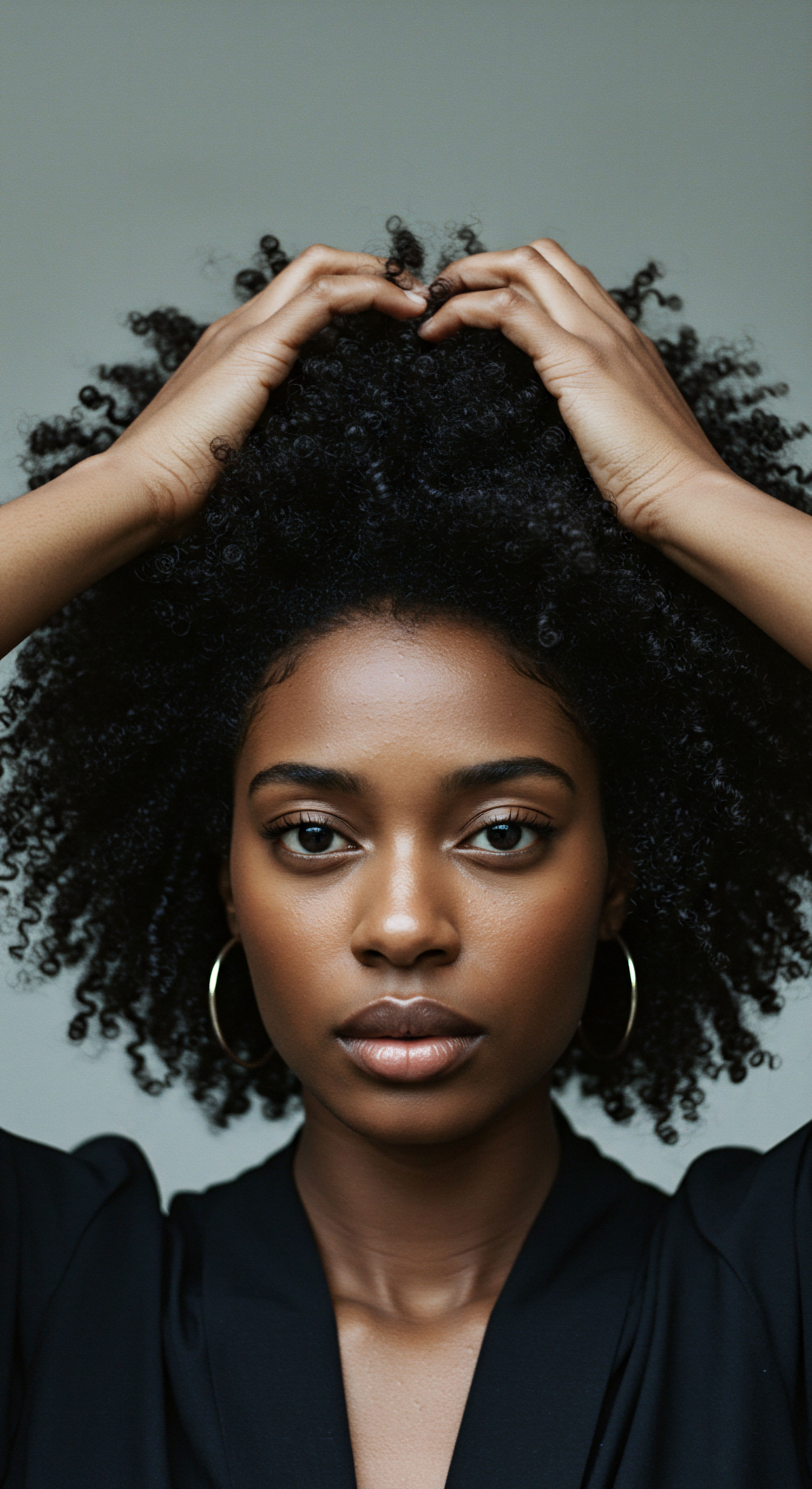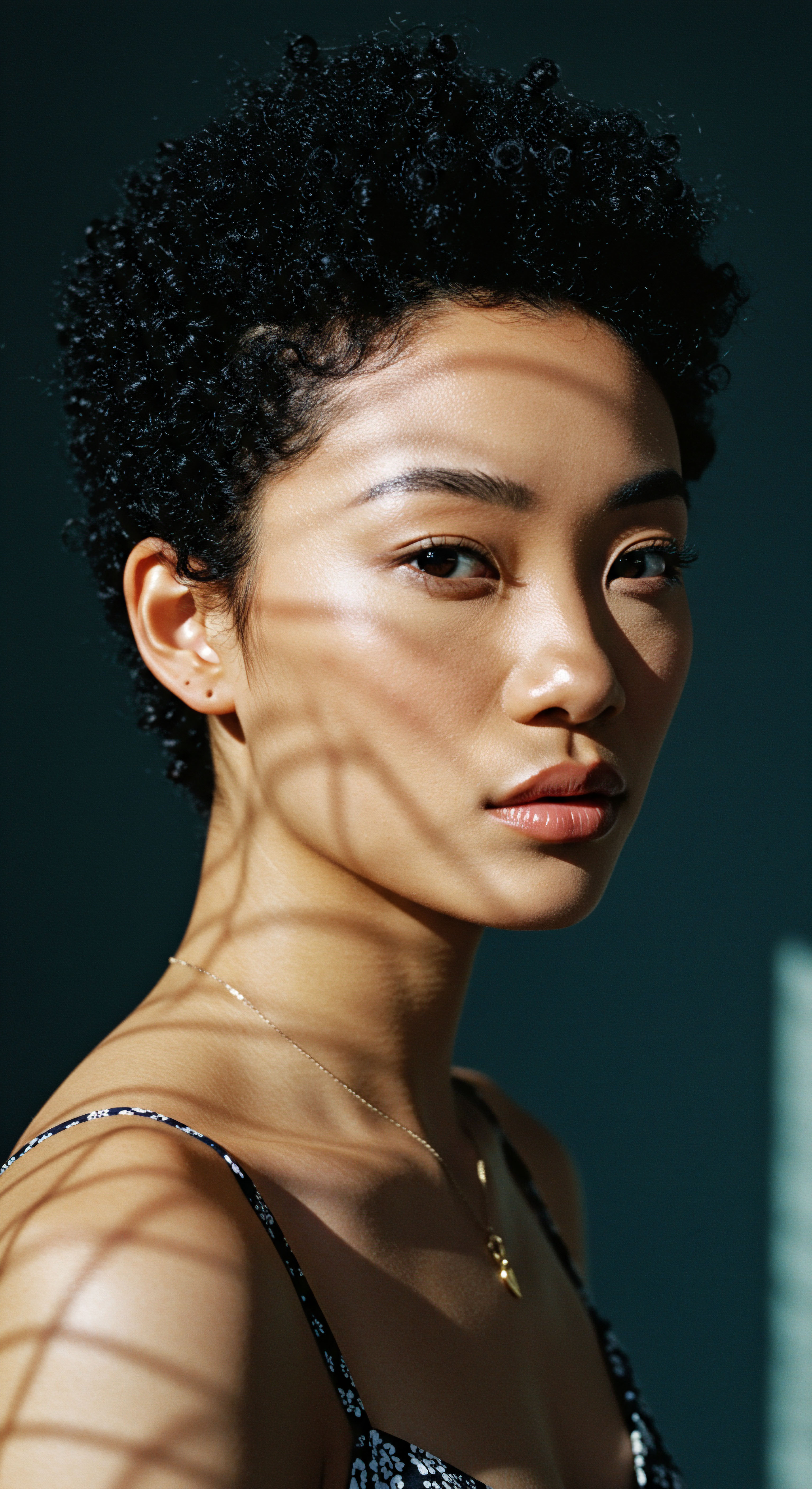
Roots
Have you ever considered the quiet symphony happening within your being as you drift into slumber? Beyond the gentle ebb and flow of breath, a subtle, profound choreography unfolds, particularly within the very foundations of our hair. We often think of hair as a surface adornment, a reflection of our outer presentation, yet its vitality is deeply rooted in the unseen rhythms of our internal world. This section invites us to look beneath the surface, to explore the elemental relationship between the nightly quietude and the vibrant life of each strand, a connection more intimate than we might first perceive.

Hair Follicle Anatomy and Textured Hair Physiology
The hair follicle, a miniature organ residing within the skin, serves as the anchor and growth engine for every hair strand. Each follicle is a complex structure, comprising the dermal papilla, a cluster of cells providing nourishment, and the hair matrix, where cells rapidly divide to form the hair shaft. For textured hair, this intricate design holds particular significance. The helical shape of the follicle itself dictates the curl pattern of the hair that emerges, from gentle waves to tightly coiled spirals.
This unique architecture means that the journey of nutrients and cellular signals to the growing hair is nuanced, navigating the curves and turns of its path. The very structure of the follicle in textured hair can influence how efficiently it receives the necessary building blocks for robust growth, making its internal environment, including sleep’s influence, all the more relevant.
The dermal papilla, positioned at the base of the follicle, acts as a communication hub, sending signals that regulate the growth and resting phases of the hair. Surrounding it, the hair matrix cells are among the most rapidly dividing cells in the human body. Their tireless work constructs the hair shaft, pushing it upwards through the follicle. This continuous activity requires a steady supply of energy and specific biochemical cues.

Hair Growth Cycles and Systemic Factors
Hair does not grow continuously; instead, each follicle follows a distinct, cyclical pattern of activity. This cycle consists of several phases, each playing a vital role in the life of a hair strand.
- Anagen ❉ This is the active growth phase, where hair cells rapidly divide, and the hair shaft extends from the follicle. For scalp hair, this period can span years, determining the ultimate length a strand can achieve. A significant majority of our hair, typically 85-90%, resides in this growing phase at any given moment.
- Catagen ❉ A brief transitional phase, lasting only a few weeks. During this time, the hair follicle shrinks, and the lower part of the follicle regresses, preparing for the resting phase.
- Telogen ❉ The resting phase, which lasts for a few months. The hair remains in the follicle, but no active growth occurs. At the end of this phase, the hair is released. Approximately 9% of hair follicles are in this resting state at any time.
- Exogen ❉ The shedding phase, where the old hair detaches from the follicle and falls out, making way for a new hair to begin its anagen journey.
These cycles are not isolated events within the scalp; they are deeply influenced by the body’s overall systemic state. Hormones, nutrient availability, and even our psychological landscape play significant roles. A variety of factors can promote the transition from the active growth (anagen) phase to the resting (telogen) phase, including inflammation, hormonal shifts, heightened psychological strain, and insufficient nutrient intake. Conversely, processes that enhance blood flow and deliver growth factors can encourage follicles to re-enter the anagen phase, promoting continued hair growth.
The hair follicle’s vitality is deeply rooted in the unseen rhythms of our internal world, with its unique structure in textured hair influencing how efficiently it receives growth signals.

Ritual
As the day yields to dusk, a different kind of daily practice begins, one that quietly shapes our very essence. We often consider our evening routines in terms of preparation for the next day, yet within these quiet hours lies a profound opportunity for the body to renew and restore. For our hair, these nocturnal practices are not merely about external care, but about allowing the deep, internal work of regeneration to unfold. This section steps into that space of shared, practical knowledge, exploring how our nightly patterns directly influence the vibrant life of our hair.

The Body’s Nocturnal Symphony and Hormonal Balance
Sleep is far from a passive state; it is a period of intense physiological activity, a symphony of cellular repair and hormonal regulation. Our sleep cycles, alternating between light, deep (non-REM), and REM sleep, orchestrate the release of critical biochemical messengers. During the restorative deep sleep phases, the body significantly boosts the production of human Growth Hormone, a key player in cellular regeneration across all tissues, including the hair follicles. This hormone directly stimulates the cells at the root of the hair, supporting healthy hair growth.
Alongside growth hormone, Melatonin, the hormone best known for regulating our sleep-wake cycle, holds a compelling role in hair biology. Produced primarily by the pineal gland, melatonin levels naturally rise with darkness, signaling the body to prepare for rest. Beyond its sleep-inducing qualities, melatonin acts as a powerful antioxidant, protecting hair follicles from oxidative stress, a process that can lead to damage and accelerated hair loss. Some research even suggests that melatonin may directly stimulate hair growth by prolonging the anagen phase of the hair cycle.
Conversely, sleep disruption can lead to an unwelcome guest ❉ elevated levels of Cortisol. This stress hormone, typically highest in the morning and lowest at night, becomes dysregulated when sleep is insufficient or fragmented. Sustained high cortisol levels can push hair follicles prematurely into the resting (telogen) phase, leading to increased shedding, a condition often termed telogen effluvium. The delicate balance of these hormones, deeply intertwined with our sleep patterns, directly influences the vitality and longevity of each hair strand.

How Does Insufficient Sleep Affect Hair Follicle Health?
When sleep patterns become erratic or consistently insufficient, the consequences for hair health can be considerable. The body’s natural restorative processes, typically optimized during deep sleep, are curtailed. This leads to a cascade of effects that can undermine the hair follicle’s ability to thrive.
One of the most significant impacts stems from the altered hormonal landscape. As mentioned, prolonged sleep deprivation can elevate cortisol, which, in turn, can suppress the regenerative capacity of hair follicle stem cells. A study from Harvard indicated that elevated cortisol levels can hinder the regeneration of hair follicles, holding them in a prolonged resting state. This makes it more challenging for the body to replace shed hair, especially if the cycle of stress and sleep deprivation persists.
Furthermore, impaired sleep can compromise blood flow to the scalp. During restful sleep, circulation to the scalp improves, ensuring that hair follicles receive a steady supply of oxygen and essential nutrients. When sleep is disrupted, this vital delivery system can be compromised, leaving follicles undernourished and weakened. This deprivation can lead to miniaturization of the follicles, causing hair to become thinner and more fragile over time.
The nightly choreography of sleep directly impacts hair health, regulating hormones like growth hormone and melatonin that support growth, while disrupted sleep can elevate cortisol, potentially shortening the active hair growth phase.
A particularly compelling, albeit perhaps less commonly discussed, observation connects sleep disturbances with autoimmune hair loss conditions. While the precise cause-and-effect relationship remains an active area of research, studies consistently reveal a link between sleep quality and conditions such as Alopecia Areata. For instance, a substantial Taiwanese study revealed that individuals with alopecia areata had a significantly higher risk of developing obstructive sleep apnea and non-apnea insomnia. Conversely, the same study, along with a large Korean retrospective analysis, suggested that a sleep disorder might predispose individuals, particularly those under 45, to a higher risk of developing alopecia areata.
The prevailing theory points to prolonged sleep deprivation triggering immune dysregulation and chronic inflammation, which can then exacerbate autoimmune responses against hair follicles. This highlights a profound, intricate relationship where sleep is not just a luxury, but a fundamental regulator of the body’s protective mechanisms, with direct consequences for hair vitality.
| Sleep Stage Deep Sleep (Non-REM) |
| Hormonal Activity Increased Growth Hormone, Melatonin |
| Hair Follicle Impact Promotes cell regeneration, extends anagen phase, protects follicles from oxidative stress. |
| Sleep Stage REM Sleep |
| Hormonal Activity Supports cognitive and emotional regulation, indirect impact on overall body systems. |
| Hair Follicle Impact Contributes to overall systemic health, indirectly supporting a balanced hair cycle. |
| Sleep Stage Disrupted Sleep |
| Hormonal Activity Elevated Cortisol, Reduced Growth Hormone and Melatonin |
| Hair Follicle Impact Can shorten anagen, hasten telogen, weaken follicles, and potentially trigger excessive shedding. |
| Sleep Stage Understanding these nocturnal processes helps us appreciate the holistic connection between rest and hair health. |

Relay
As we move beyond the immediate biological responses to sleep, a more expansive vista opens, revealing the intricate interplay of forces that sculpt our hair’s destiny. The question of how sleep patterns influence hair growth extends far beyond simple hormonal shifts; it invites us into a profound exploration where science, cultural wisdom, and the subtle nuances of daily existence converge. This section seeks to illuminate these less apparent complexities, inviting a deeper, more reflective consideration of sleep’s multifaceted role in our hair’s journey.

Beyond the Biological Clock What Else Influences Hair Growth?
The circadian rhythm, our body’s internal clock, synchronizes numerous physiological processes with the 24-hour cycle of day and night. Hair follicles themselves possess their own intrinsic circadian clocks, which modulate their activity and sensitivity to various signals. When our sleep patterns are chronically misaligned with this natural rhythm, the communication within these follicular clocks can falter. This desynchronization can disrupt the delicate timing of the hair growth phases, potentially leading to a shorter anagen phase and a prolonged telogen phase, thus accelerating shedding.
Moreover, sleep is a cornerstone of overall cellular repair and systemic health. During restful periods, the body performs vital tasks like clearing metabolic waste, repairing cellular damage, and consolidating memory. A sustained lack of quality sleep can compromise these fundamental processes, leading to widespread low-grade inflammation.
This systemic inflammation can negatively affect the scalp environment, making hair follicles more vulnerable to damage and hindering their regenerative capacity. The scalp, as the foundation for hair, relies on a healthy, balanced state, and disrupted sleep can undermine this equilibrium, potentially manifesting as increased sensitivity or irritation.
The body’s ability to absorb and utilize nutrients is also deeply tied to sleep. While specific nutrient deficiencies can directly affect hair health, poor sleep can impair the body’s efficiency in absorbing these vital elements from our diet. For instance, biotin, zinc, and iron are crucial for hair health, and even with adequate dietary intake, their absorption can be compromised by chronic sleep deprivation. This subtle yet significant impact on nutrient delivery further underscores how sleep serves as a silent partner in hair vitality.

Are There Cultural Reflections on Rest and Hair Care?
Across various cultures and throughout history, the connection between rest, ritual, and hair care has been implicitly understood, even if not always articulated through modern scientific terms. Many ancient traditions recognized the restorative power of night and incorporated practices aimed at preserving hair health during sleep. For instance, in some African and Afro-diasporic cultures, the tradition of wrapping or covering textured hair at night with silk or satin scarves and bonnets was not only about maintaining hairstyles but also about protecting the delicate strands from friction, moisture loss, and breakage that could occur during restless sleep. These practices, passed down through generations, speak to an intuitive understanding of hair’s vulnerability during periods of unconscious movement.
Similarly, rituals involving scalp massage with nourishing oils before bed, found in Ayurvedic traditions, aimed to promote relaxation, improve circulation, and condition the hair and scalp. While the immediate intent might have been comfort or cosmetic, the underlying benefit of enhanced blood flow and a calming routine would have undoubtedly supported the hair’s natural growth cycles by optimizing the conditions for cellular repair and hormone regulation during sleep. These time-honored customs serve as a collective wisdom, a gentle reminder that the holistic care of our hair is often intertwined with the profound act of restful slumber.
Sleep’s influence on hair growth extends beyond simple hormone shifts, affecting the intrinsic clocks within follicles, systemic inflammation, and nutrient absorption, a connection recognized through both modern science and ancient cultural practices.

The Interconnected Web of Well-Being and Hair Vitality
The relationship between sleep patterns and hair health is a compelling illustration of the body’s profound interconnectedness. Hair vitality is not an isolated phenomenon; it is a sensitive barometer of our overall well-being. When we consider the profound biological processes that unfold during sleep—hormone regulation, cellular repair, immune system modulation, and even psychological restoration—it becomes clear that disrupting this fundamental rhythm sends ripples throughout the entire system, ultimately affecting the hair follicle’s ability to perform its function.
For individuals with textured hair, this connection can feel particularly resonant. The unique structural characteristics of curls and coils often mean they are more susceptible to dryness and breakage, making any disruption to the internal processes that support moisture retention and strength more apparent. A good night’s rest, therefore, becomes not just a personal comfort, but a silent, yet potent, ritual that supports the very resilience and vibrancy of textured strands. It speaks to a deeper truth ❉ that true beauty emanates from a state of internal balance, where every part of our being, down to the smallest hair follicle, is nurtured by the restorative power of repose.

Reflection
As we draw this exploration to a gentle close, a quiet understanding settles. The journey into how our sleep patterns shape the life of our hair follicles reveals a truth both scientific and deeply personal ❉ the rhythm of our rest is a silent, powerful sculptor of our vitality. Each night offers a tender invitation for renewal, a space where our inner landscape tends to the delicate needs of our outer crown.
Perhaps the deepest beauty secret lies not in elaborate potions, but in the profound, accessible grace of a truly restorative slumber. What small, intentional gestures might you invite into your evening, knowing the quiet, lasting impact they hold for the life that blooms from your scalp?

References
- 1. Centre Clauderer. Hair and sleep ❉ the importance of the night for hair health.
- 2. Oh, J. W. Wang, E. A. & Bikle, D. D. (2014). The biology of hair follicles ❉ The hair cycle. Dermatologic Clinics, 32(1), 1-14.
- 3. DiStefano Hair Restoration Center. Does Sleep Affect Hair Health?
- 4. Hair Doctors. Can Lack of Sleep Make You Lose Hair? Uncovering the Connection.
- 5. HHC Clinics. Sleep and Hair Growth – What’s the Connection?
- 6. Birmingham Dermatology Clinic. Melatonin stopping hair loss?
- 7. The Hairy Pill. Does Lack of Sleep Cause Hair Loss? Uncovering the Connection.
- 8. Han, C. Li, S. Wang, L. & Hu, J. (2023). Melatonin’s Role in Hair Follicle Growth and Development ❉ A Cashmere Goat Perspective. International Journal of Molecular Sciences, 24(17), 13359.
- 9. Ms.Medicine. Beauty Sleep Guide ❉ How Sleep Affects Skin & Hair Health.
- 10. Faghihi, G. & Khosravi, H. (2022). Sleep disturbance in alopecia areata ❉ A cross-sectional study. Journal of Cosmetic Dermatology, 21(4), 1686-1691.
- 11. DS Laboratories. Sleep and Hair Growth ❉ How Your Nighttime Hair Care Routine Impacts Your Hair.
- 12. Wellbeing Nutrition. Can A Lack of Sleep Cause Hair Loss? The Science Explained.
- 13. Refine Pharma. Benefits of Sleep for Your Skin, Hair and Nails.
- 14. L’Oréal Paris. How Does Sleep Affect Your Hair Health & Growth?
- 15. Hughes, S. J. & Sperling, L. C. (2015). Integrative and Mechanistic Approach to the Hair Growth Cycle and Hair Loss. Journal of Clinical and Aesthetic Dermatology, 8(2), 26-32.
- 16. HairFree & HairGrow. Melatonin for Hair Loss & Growth, Here’s Everything You Need to Know.
- 17. Luxury Lash Academy. The Connection Between Hair Health and Sleep for Stylists.
- 18. Dr Nagwani. Sleep and Hair Growth ❉ What’s the Connection?
- 19. Treatment Rooms London. Can A Lack of Sleep Cause Hair Loss?
- 20. Harley Street HTC. Hair Growth Cycle ❉ 4 Stages Explained.
- 21. Wellbeing Nutrition. The Connection Between Sleep & Hair Growth.
- 22. Babadjouni, A. Reddy, M. Zhang, R. et al. (2023). Melatonin and the human hair follicle. Journal of Drugs in Dermatology, 22(3), 260-264.
- 23. hairlove. Sleeping Beauty — A Closer Look at Your Sleep Cycle.
- 24. Wellbeing Nutrition. How does Melatonin Help Regulate Hair Growth?
- 25. Harley Street HTC. What Can You Do to Try and Maintain Hair Health During These 4 Stages?
- 26. RHRLI. Is Sleep Important for Hair Growth?
- 27. Fischer, T. W. & Elsner, P. (2009). The influence of melatonin on hair physiology. Hautarzt, 60(12), 962-972.
- 28. Wellbel. Sleep and Hair Health ❉ How Are They Connected?
- 29. Zhang, Z. et al. (2023). Melatonin-Mediated Circadian Rhythm Signaling Exhibits Bidirectional Regulatory Effects on the State of Hair Follicle Stem Cells. Cells, 12(23), 2735.
- 30. Waskiewicz, A. et al. (2021). Hair Cortisol Concentration as a Biomarker of Sleep Quality and Related Disorders. International Journal of Molecular Sciences, 22(20), 11060.
- 31. DUTCH Test Blog. Stress, Hair Loss, and Cortisol Connection.
- 32. Zhang, X. et al. (2019). Circadian rhythm disruption affects hair follicle stem cell activity. Cell Reports, 29(1), 123-134.
- 33. Waskiewicz, A. et al. (2021). Sleep disorders associated with high cortisol levels in both adults and children. International Journal of Molecular Sciences, 22(20), 11060.
- 34. National Hair Centers. Does Lack of Sleep Cause Hair Loss? The Science Explained.